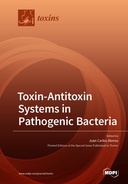Explore

Toxin-Antitoxin Systems in Pathogenic Bacteria
0 Ungluers have
Faved this Work
Login to Fave
Bacterial toxin–antitoxin (TA) systems, which are ubiquitously present in bacterial genomes, are not essential for normal cell proliferation. The TA systems regulate fundamental cellular processes, facilitate survival under stress conditions, have essential roles in virulence and represent potential therapeutic targets. These genetic TA loci are also shown to be involved in the maintenance of successful multidrug-resistant mobile genetic elements. The TA systems are classified as types I to VI, according to the nature of the antitoxin and to the mode of toxin inhibition. Type II TA systems encode a labile antitoxin and its stable toxin; degradation of the antitoxin renders a free toxin, which is bacteriostatic by nature. A free toxin generates a reversible state with low metabolic activity (quiescence) by affecting important functions of bacterial cells such as transcription, translation, DNA replication, replication and cell-wall synthesis, biofilm formation, phage predation, the regulation of nucleotide pool, etc., whereas antitoxins are toxin inhibitors. Under stress conditions, the TA systems might form networks. To understand the basis of the unique response of TA systems to stress, the prime causes of the emergence of drug-resistant strains, and their contribution to therapy failure and the development of chronic and recurrent infections, must be known in order to grasp how TA systems contribute to the mechanisms of phenotypic heterogeneity and pathogenesis that will enable the rational development of new treatments for infections caused by pathogens.
This book is included in DOAB.
Why read this book? Have your say.
You must be logged in to comment.
Rights Information
Are you the author or publisher of this work? If so, you can claim it as yours by registering as an Unglue.it rights holder.Downloads
This work has been downloaded 83 times via unglue.it ebook links.
- 83 - pdf (CC BY) at Unglue.it.
Keywords
- Addiction
- anti-addiction
- Antibacterial Agents
- antibiotic resistance
- antitoxin
- Bacteria
- bacterial cell death
- bacterial persistence
- Biofilm
- cell wall inhibition
- clinical origin
- cognate interactions
- cross-interactions
- cross-resistance
- cross-talk
- environmental origin
- Fst/Ldr family
- Klebsiella pneumoniae
- M. tuberculosis
- mazF
- medicine
- molecular insulation
- mRNA interferase
- n/a
- NAD+
- nucleotide hydrolysis
- opportunistic pathogen
- Pathogenesis
- PemI/PemK
- Persistence
- protein interface
- protein–protein interactions
- small protein toxin structure
- Stenotrophomonas maltophilia
- stress-response
- TA systems
- tolerance
- toxin
- toxin activation
- toxin-antitoxin system
- toxin-antitoxin systems
- toxin–antitoxin
- toxin–antitoxin system
- toxin–antitoxin systems
- Tuberculosis
- type I toxin–antitoxin system
- type II
- uridine diphosphate-N-acetylglucosamine
- X-ray crystallography
Links
DOI: 10.3390/books978-3-0365-0675-3Editions

